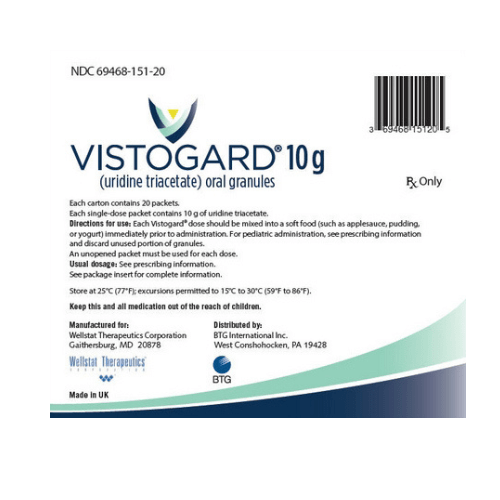
In the realm of treatment, fluorouracil (5-FU) and capecitabine are two commonly employed medications. While these drugs have proven effective in combating various types of cancer, they also pose a risk of severe toxicity, particularly when taken in excessive amounts. Enter Vistogard (uridine triacetate), a life-saving medication that serves as an antidote for fluorouracil and capecitabine overdoses.
FDA Approval
On December 11, 2015, the FDA granted Vistogard its approval, recognizing its crucial role in mitigating the potentially fatal consequences of fluorouracil and capecitabine overdoses. This landmark decision paved the way for Vistogard to become an essential tool in emergency care settings.
Manufacturing Details:
Maintaining Quality and Precision, Wellstat Therapeutics Corporation, a distinguished pharmaceutical company, rigorously produces Vistogard with meticulous attention to stringent quality control measures. The drug’s creation involves a precise chemical synthesis process, ensuring uniformity and effectiveness.
Indication and Usage:
Vistogard is a pyrimidine analog designed for the urgent care of adult and pediatric patients:
- Following an overdose of fluorouracil or capecitabine, irrespective of symptoms.
- In cases of early-onset, severe, or life-threatening toxicity impacting the cardiac or central nervous system, and/or unusually severe adverse reactions (e.g., gastrointestinal toxicity and/or neutropenia) occurring within 96 hours after concluding fluorouracil or capecitabine administration.
Usage limitations:
- Vistogard is not recommended for the non-emergent management of adverse reactions associated with fluorouracil or capecitabine, as it may compromise the effectiveness of these drugs.
- The safety and effectiveness of Vistogard when initiated more than 96 hours after completing fluorouracil or capecitabine administration have not been established.
How To Consume Vistogard?
Recommended Dosage
- Adults: Take 10 grams (1 packet) orally every 6 hours for a total of 20 doses, regardless of meals.
- Pediatric: Administer 6.2 grams/m2 of body surface area (not exceeding 10 grams per dose) orally every 6 hours for 20 doses, irrespective of meals.
Preparation and Administration
- For pediatric doses, measure using a scale accurate to at least 0.1 gram or a graduated teaspoon accurate to ¼ teaspoon.
- Combine each Vistogard dose with 3 to 4 ounces of soft foods like applesauce, pudding, or yogurt. Consume within 30 minutes without chewing the granules. Follow with at least 4 ounces of water.
Special Considerations
- If vomiting occurs within 2 hours of a Vistogard dose, administer another full dose promptly after the episode. Proceed with the next scheduled dose.
- In case of a missed dose, administer it as soon as possible and continue with the regular schedule.
- When necessary (e.g., severe mucositis or coma), administer Vistogard through a nasogastric tube (NG tube) or gastrostomy tube (G-Tube).
Ensuring adherence to these guidelines is crucial for the effective utilization of Vistogard. Consult your healthcare provider for any queries or concerns regarding the administration of the medication.
Warnings and Precautions:
The FDA label states that Vistogard has no warnings, or precautions listed.
Contraindications:
Vistogard is contraindicated in patients with a known hypersensitivity to uridine triacetate or any of the excipients in the drug. This contraindication ensures that the potential benefits of Vistogard outweigh the risks for each patient.
Usage Of Specific Population
Pregnancy
Limited data on uridine triacetate during pregnancy are inconclusive for birth defect and miscarriage risks. In studies on pregnant rats at half the recommended human dose, there was no evidence of teratogenicity or harm to the fetus. Background risks for major birth defects and miscarriage in this population are unknown, with general population estimates at 2-4% and 15-20%, respectively.
Lactation
No data exist on the presence of uridine triacetate in human milk, its effects on the breastfed infant, or on milk production. Consideration of breastfeeding benefits and the mother’s clinical need for Vistogard is advised, weighing potential adverse effects on the breastfed infant from Vistogard or the underlying maternal condition.
Pediatric Use
The safety and effectiveness of Vistogard have been confirmed in pediatric patients. Pediatric use is supported by two open-label clinical studies, including a study with 6 patients aged 1 to 16 years. Clinical response and safety were similar in adults and pediatric patients; however, data are limited
Geriatric Use
In clinical studies with 135 Vistogard patients, 30% were 65 and over, including 11% aged 75 and over. The studies did not include enough subjects aged 65 and over to determine potential differences in response compared to younger subjects.
Side Effects:
The most common side effects associated with Vistogard include injection site reactions, headache, fatigue, upper respiratory tract infection, nausea, vomiting, diarrhea, and abdominal pain. While these side effects are often manageable, patients should be informed of their potential occurrence.
Storage Condition
Store Vistogard oral granules at room temperature, maintaining it between 68°F to 77°F (20°C to 25°C). Ensure that Vistogard and all medications are stored in a location inaccessible to children.
Recent Advancements:
Ongoing research is exploring Vistogard’s potential beyond fluorouracil and capecitabine overdose, with promising results in treating chemotherapy-induced neuropathy and radiation-induced mucositis. These advancements could expand Vistogard’s therapeutic applications, offering relief to patients with these challenging conditions.
Online Procurement Of Vistogard
Obtaining Vistogard is now more convenient through online channels. For this medication, available exclusively in the US and Europe, consider reaching out to the SANSFRO team or similar import-specialized companies. To determine the Vistogard cost, contingent on various factors and specifications, contact our Patient Support Team at (91) 93157 05373 or via email at help@sansfro.com. Stay updated on accurate pricing in the Indian market through our dedicated team.
Conclusion:
Vistogard, with FDA approval, meticulous manufacturing, and proven efficacy, is a beacon of hope in fluorouracil and capecitabine overdose emergencies. Despite careful administration due to warnings, its potential benefits outweigh risks. Ongoing research and recent therapeutic advancements reinforce its vital role, promising improved patient outcomes. Vistogard remains a cornerstone in emergency treatment, providing a crucial lifeline for those in need.
Reference



